In this article, you can read my review of Carcassonne, a gateway tile-placement board game. What is Carcassonne, how does it play, and do I recommend it?
Introduction Carcassonne – Board Game Review
I’ve always been fascinated by maps. As a kid, I would browse the world atlas just for fun, checking out the layouts of cities and the countryside and cursing the authors for not selecting more city maps or enlarging certain parts of the map that I was more interested in.
It is therefore not a surprise, that map-based or tile-placement games (computer games or board games) have a special place in my heart.
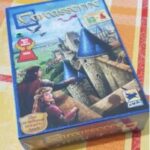
Unboxing
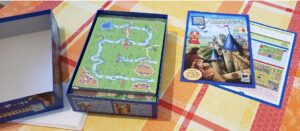 There aren’t really that many different components in the box: besides instructions you have the tiles, you have your figures (Meeples as they are called), and a scoring board. Decent quantity though: over 80 tiles and over 40 meeples, so there is plenty of building material available.
There aren’t really that many different components in the box: besides instructions you have the tiles, you have your figures (Meeples as they are called), and a scoring board. Decent quantity though: over 80 tiles and over 40 meeples, so there is plenty of building material available.
Carcassonne – First Impressions
Everything in the box scents of quality and style. Meeples are made of wood and are very distinctly shaped. The tiles are of course cardboard, but the artistic style on them … I cannot praise it enough. The images on them are brilliant and not two of them are the same. Attention to detail is high: a village here, a garden over there, just a couple of random trees by the road, the winding roads, the farms …
The tiles look impressive on themselves, but when you start putting them together and building a landscape, it all goes a notch or two higher. Combined, the tiles form an amazingly looking picturesque medieval world.
I couldn’t help myself and imagine how it would be to walk the roads, see the bustling cities, or just lie in the shade of the trees in the nearby garden. Compiling this landscape is one of the key selling points of Carcassonne. You don’t even have to play the game, you can just take the tiles and try to build an impressive map.
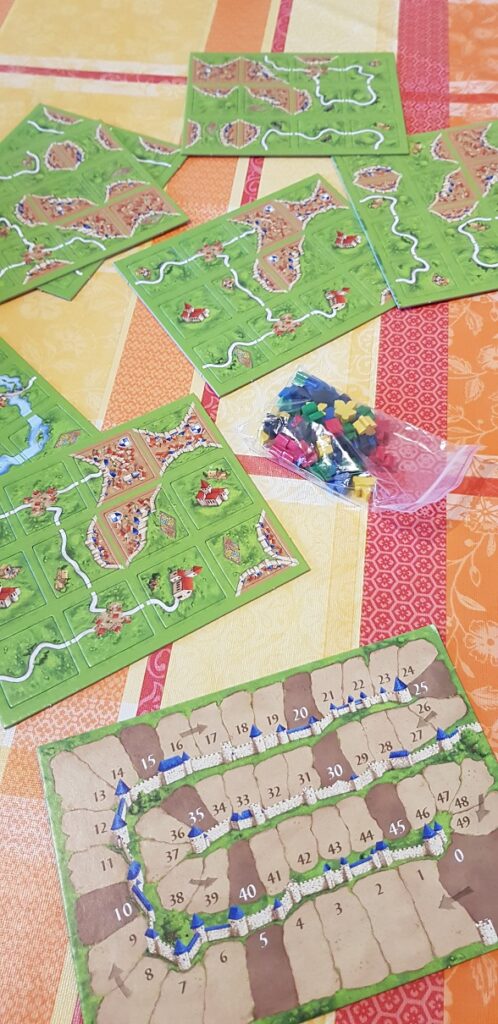
Basics of Gameplay
Carcassonne does not have very complicated game mechanics, especially the base game. Players draw tiles and place them next to existing ones so that the pictures on them match and they form a landscape full of features: cities, roads, fields, and monasteries.
Tile tiles are drawn one by one. As players place them they have the option to put their meeple figure on any of the features on that tile: when that feature is completed (a road, a city, or a monastery), they receive victory points and get their meeple back.
Meeples on the fields are calculated when the game is finished and are therefore a long-term investment. The scoring system seems pretty complicated at first, but you soon get a grasp on it and realize it’s very straightforward and easy to understand. In the end, the player with the most victory points wins the game.
There is of course plenty of strategies involved when placing the tiles: trying to build features for yourself and trying to obstruct other players. Managing your meeples is another important aspect: how many will you commit to fields and how many will you keep in reserve? Investing in fields is crucial for scoring big at the end game. Predicting how the game will pan out and which fields will be the most profitable needs both skill and a bit of luck.
Luck also plays a part when you draw a new tile. Will you get the one you need? Fortunately, each tile can be placed in various ways, so there are usually plenty of options available.
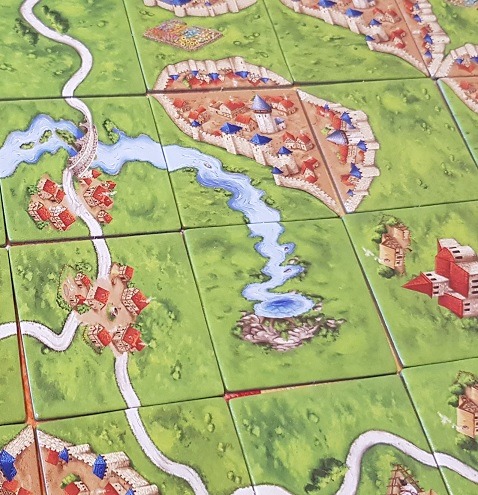
Carcassonne Expansions
The base game is only the tip of the iceberg. Carcassonne so far received 10 major expansions, 13 smaller expansions, and 7 stand-alone mini-expansions. Expansions are often available together in compilation boxes. So, if you get immersed in this game, there is no fear of running out of novelty any time soon.
Did you know Carcassonne is still on the list of most popular board games?
Below are all the expansions listed chronologically, just for orientation and to see how many of them there are. Instead of buying them one by one, I suggest you look out for Compilation boxes, which include a number (of thematically related) expansions in a package.
Full expansions:
- Inns and Cathedrals
- Traders and Builders
- The Princess and the Dragon
- The Tower
- Abbey and Mayor
- Count, King & Robber
- The Catapult
- Bridges, Castles & Bazaars
- Hills & Sheep
- Under the Big Top
Mini expansions:
- The River
- King and Scout
- The Cathars
- The Count of Carcassonne
- The River II
- The Mini-Expansion
- The Cult
- Tunnel
- Crop Circles
- The Plague
- The School
- The Festival
- The Phantom
- The Watchtower
- The Markets of Leipzig
- The Fruit-bearing Trees
- Carcassonne Minis: The Flying Machines, The Messengers, The Ferries, The Gold Mines, Mage & Witch, The Robbers, Corn Circles II
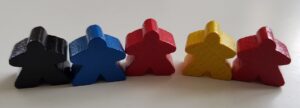
Carcassone Universe
Since the game is so successful, several games were published as spin-offs. These share similar game mechanics or themes:
- Carcassonne: Hunters and Gatherers
- The Ark of the Covenant
- Carcassonne: The Castle
- Carcassonne: The City
- Carcassonne: The Discovery
- New World: A Carcassonne Game
- My First Carcassonne
- Cardcassonne
- Carcassonne: The Dice Game
- Carcassonne: Winter Edition
- Carcassonne: South Seas
- Carcassonne: Gold Rush
- Carcassonne: Over Hill and Dale
- Carcassonne: Star Wars
- Carcassonne: Amazonas
- Carcassonne: Safari
If anyone asks you have you ever played Carcassone, there is no simple yes or no, but rather a counter-question: which one? Oh, have I mentioned video game versions? 🙂
(All of the above lists were created with a lot of help from Wikipedia.)
Conclusion
Carcassonne is an excellent way to get into board gaming. You can teach it to anyone in a matter of minutes (you might want to ignore farmers for the first game), and even your non-gamer friends will enjoy building cities and roads. The base game is alright to start out, but it will sooner or later run out of steam. Luckily, expansions are there to carry you forward, introducing many interesting game mechanics, tiles, and pieces.
For an experienced board gamer, Carcassonne might be of limited value long-term, but even they will appreciate the elegance, simplicity, and enjoy playing it occasionally.
You can play Carcassone online at AsoBrain.
Read about Isle of Skye, another tile placement board game
What are your thoughts on Carcassonne? Which expansions and spin-offs have you played and which are your favorite?
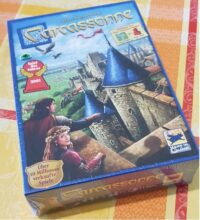
Hello and thank you for posting.
This looks interesting but can I ask, what is the true purpose of the game? How do you win?
I guees victory conditions are so obvious, I forgot to mention them. 🙂
It comes down to who has more points. I’ll write a follow up article about Carcassonne for sure.
Wow, this is a very good introduction into the Carcassonne board game. Actually, it’s the first time that I am hearing about the game and from your explanation, it sounds like a game that will enjoy playing a lot. One thing that I think is a bit of a problem is that it looks like a game that will require some jigsaw skills to be able to play. I will try to play it sometime. Thanks alot.
The jigsaw thing is not a problem, it’s actually a very fun part of the game trying to fit the pictures on the tiles toghether.
This seems a lot like a game I would like to play. I also have always been exciting about maps and I also were always checking world atlas just for fun as a kid.
I love board games, I love exploration, conquesting, building civilization games, and as I understood this is the case here for carcassonne.
What is the minimum age indicated by game to enjoy and understand the game?
The box suggests ages 7+, but it’s not really a complicated game. So if your kids are interested, you could go a year lower than that.
That’s for understanding how the game is played. For playing well and understaning winning strategies, i’d say 8+.
Hello Vasilij, I must say that this article is very helpful and informative. I heard about this game but I decided to check for it on the Net. It looks pretty interesting, I am so intrigued to try it. I found it very helpful when it comes to kids. I have 2 sons of 5 and 6 years and this would be great playing instead of computer games.
They’re actually the perfect age to start playing. And you’re right, it’s definitely better than computer games – time spent together with your family is priceless.
We are always looking for new board games! We have a LOT of family coming up for the holidays this year, so we will need fun (and safe) ways for everyone to be entertained and compete in a healthy manner. I too have always liked map-based games (Risk, Catan, etc.), so I think I could be into this one too. You might have mentioned it in your article but I didn’t find it: how many people can play the base version of Carcassone?
Up to five players, so the whole family can play at once. But the game play best with less players, 2-3.
Thanks for this great article about carcassonne board game because I got to know it from here because I don’t know what its all about and I have never played one, but by reading this article I have got the knowledge and am gonna try some out as mentioned earlier. Thanks very much in advance.
I’m glad the article was helpful!
A very interesting game concept that uses map building as a mechanic. I would imagine one could get wrapped up in playing this. I like the concept of building your own map as you go. The fact that you can add other expansions means it can go on over a long time frame. How many people could play this at one time?
Up to five people can play at once. But that would make it a bit too crowded, in my opinion. 2-3 players is the sweet spot for Carcassonne.
The Carcassonne board game sounds like a very good board game that even I should give a try. It is not the first time that I a hearing about the game but I have not learnt anything about it yet. That is something I will very much love to do. Thank you for giving an insight into the game. Cheers!
You can give it a try online for free. Check this article.
Carcassone is indeed a game of luck and from its description here it plays to me that anybody can win and is not about having to be a guru in the game which further makes it a general game. Card games are quite fascinating to play but here it seen really straight forward. Is there any tile card that would cause you to lose a point or get penalized like you will have to drop a meeple or something?
Luck does not actually play that big of a role as you would think. Most of the tile cards can be placed in a lot of different ways, so you always have options (that means there is skill involved) and it’s not that straightforward. Not to mention the placement of your meeples, where you really have to have a strategy.
Answering your question – ther is no such tile card. The most negative thing that can happen during a game is, when one of the opponents “takes over” a feature (a city for exapmle) by placing more meeples on it. Then you do lose a meeple in a way.
I’ve played this game a lot and love it. It can actually expand up to 6 people. Depending on the people playing it can actually be a lot of fun. Depending on the expansions you use and if you’re using farms you CAN lose potential points.
But isn’t a 6-player game a bit chaotic? 🙂